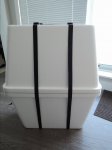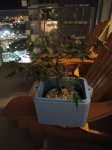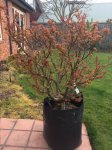Hello Rockm!!!
When you mention supports at the bottom of the pot, did you mean bottom of the bonsai pot or the bottom of the container that i will be putting the pot into which will have drainage holes at the bottom?
Thanks again!
I would skip the container to hold the bonsai pot. It's unnecessary and potentially a problem. The aim of mulching is to trap the ambient warmer temps of the soil below. IT IS NOT TO KEEP TREES "WARM." Adding electric heating elements to plants overwintered in this situation is not only counterproductive, it is potentially dangerous. Don't do it. If you think a particular species isn't up to the cold, find alternatives. Japanese maples are very well capable of surviving Zone 7 conditions. Don't worry about them.
You are overwintering on a balcony, which can complicate things, since it will experience wider temperature swings. Ideally, I'd try to find somewhere on the ground to overwinter, but if you have to do it on the balcony, I'd try to find a place that's out of the wind and in contact with a larger mass--such as the building wall.
FWIW, I have been overwintering in Zone 7 Virginia for over two decades now. I overwinter all of my trees (with one exception) in my backyard in garden beds under about nine inches or so of mulch. When November rolls around (exact dates vary), I pull my trees off their benches. The majority are placed on my brick patio (which is sheltered from the wind by a six foot fence), others, including my maples, are placed in the bottom of a two foot deep cold pit. Before I put them down, however, I make sure the pots are NOT resting directly on the surface below them. The pots are placed on one or two bricks at each corner of their pots. This extra clearance insures the pots will drain over the winter. Placing them directly on the patio or cold frame's bottom can wind up blocking drainage.
The maples really don't need the cold pit, but it provides a bit more protection from the winter wind.
Once the trees are all placed in their respective winter quarters, I water them all very well.
I then start adding mulch a few inches at a time.
I water the mulch if it's dry out of the bag-dry mulch can pull water out of the bonsai pots and can even wind up staying dry through the winter, repelling needed rainfall and snow melt that keep the trees moist. Moist soil is essential to keep plants safe from harder freezes, as it can act as an insulator. However, soggy soil is an enemy as it can rot roots.
I pile enough mulch to cover the trees up to three or four inches up their trunks. The more mulch in the pile, the more stable the temps underneath it.
I don't water the trees the rest of the winter, although I keep an eye on the mulch every now and then to make sure it doesn't dry out. Once it freezes, it's useless to try and water anyway.
The mulch pile usually freezes through by the end of December into early Jan. depending on the weather. That's not a bad thing. The aim of mulching is to keep root temperatures stable, but as cold as possible, for as long as possible in the winter/early spring. I don't really worry about temps that get down into single digits or even lower if the cold isn't prolonged--which usually isn't an issue in Zone 7.
In early spring, mulch becomes valuable in keeping trees cold as the days warm up. The temperature lag provided by the mulch can put off the "bonsai two step" process of having to bring trees that have broken into leaf inside during freezes.



